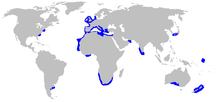
Back القرش العنبرى ARZ Бодлошипа акула Bulgarian Peix clavellat Catalan Echinorhinus brucus CEB Žralok trnitý Czech Nagelhai German Αχινοσκυλόψαρο Greek Echinorhinus brucus Spanish Tatxuela Basque کوسه خاربتهای Persian
| Bramble shark | |
|---|---|

| |
| Echinorhinus brucus, illustration of the zoology of South Africa (1838) | |

| |
| Echinorhinus brucus, mounted specimen. | |
| Scientific classification | |
| Domain: | Eukaryota |
| Kingdom: | Animalia |
| Phylum: | Chordata |
| Class: | Chondrichthyes |
| Subclass: | Elasmobranchii |
| Order: | Echinorhiniformes |
| Family: | Echinorhinidae |
| Genus: | Echinorhinus |
| Species: | E. brucus
|
| Binomial name | |
| Echinorhinus brucus (Bonnaterre, 1788)
| |

| |
| Range of the bramble shark[2] | |
| Synonyms | |
|
Echinorhinus mccoyi Whitley, 1931
| |
The bramble shark (Echinorhinus brucus) is one of the two species of sharks in the family Echinorhinidae. Aside from the eastern Pacific Ocean, it is found in tropical and temperate waters worldwide. This rarely encountered shark swims close to the bottom of the seafloor, typically at depths of 400–900 m (1,300–3,000 ft), though it may enter much shallower water. The bramble shark has a stout body with two small dorsal fins positioned far back and no anal fin. It can be readily identified by the large, thornlike dermal denticles scattered over its body, some of which may be fused together. It is purplish brown or black in color and grows up to 3.1 m (10 ft) long.
The diet of the bramble shark includes smaller sharks, bony fishes, and crabs, which this slow-moving species may capture via suction. It is aplacental viviparous, with females producing litters of 15–52 pups. Harmless to humans, it is an occasional bycatch of commercial and recreational fishers, and may be used for fishmeal and liver oil. Its population has declined substantially in the northeastern Atlantic since the 18th and 19th centuries, likely because of overfishing.
- ^ Finucci, B.; Bineesh, K.K.; Cheok, J.; Cotton, C.F.; Kulka, D.W.; Neat, F.C.; Pacoureau, N.; Rigby, C.L.; Tanaka, S.; Walker, T.I. (2020). "Echinorhinus brucus". IUCN Red List of Threatened Species. 2020: e.T41801A2956075. doi:10.2305/IUCN.UK.2020-3.RLTS.T41801A2956075.en. Retrieved 19 November 2021.
- ^ Cite error: The named reference
compagno et alwas invoked but never defined (see the help page).
